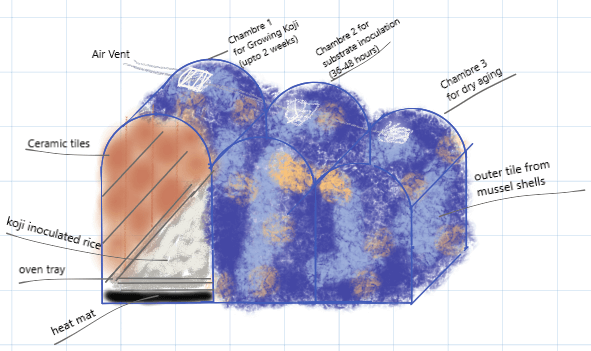
Koji Fermentation Control System
Project Goal
The goal of this project is to create a koji fermentation control system that can maintain optimal temperature and humidity conditions for koji growth, while also monitoring and logging these parameters for quality control and process optimization.
What is Koji?
Koji, a mold (Aspergillus oryzae) that has been used in Asian fermentation for millennia. It can be used to produce various foods, from miso and soy sauce to cured meats and even desserts.
Methods of Application
Amylase as a Brine
Koji's amylase enzymes break down complex carbohydrates into simple sugars. This can be utilized in a brine, such as amazake, to add a touch of sweetness and umami to meats before or during the cooking process. When used as a brine, the koji enzymes can help retain more water. A koji brine is created by using amazake to submerge the meat, then adding salt.
Amino Pastes
Soy sauce is made with a soybean and wheat mash that is added to a brine and allowed to ferment. The solids are then strained out to yield the liquid sauce. Koji's enzymes break down the plant proteins into amino acids, which contributes to the umami flavor. Amino sauces can be made with a variety of proteins. The main difference between an amino paste and an amino sauce is the water content. The higher liquid concentration in an amino sauce makes the koji enzymes more accessible to break down starches and proteins.
Shio Koji
Shio koji is a simple mixture of koji, water, and salt. It is primarily used as a short-term marinade to create tasty amino acids when applied to foods before, during, or after cooking. The high salt content limits fermentation, so its flavor influence comes from enzymatic activity.
Aging Charcuterie
Koji can be used to accelerate the aging of charcuterie. Applying koji to charcuterie allows the drying process to yield the standard water loss in a shorter time than traditional methods. Koji can also be used in wet cures by creating a koji brine with amazake, or in dry cures by incorporating ground fresh or dried koji. The use of koji introduces enzymes from the beginning of the curing process, which enhances the flavor of the cured meat.
Additional Applications
In addition to these methods, koji is also used in making alcoholic beverages, vinegars, vegetable pickles, and sweet applications. Koji can be grown on a variety of grains, beans, and other starchy materials to produce different flavors and textures. Different strains and species of koji are used to optimize for different enzymes, aromas, and levels of acidity.
Design Concept
This project aims to develop a compact fermentation system for home and small restaurant kitchens. The design focuses on precise environmental control and monitoring to ensure consistent, safe koji cultivation.
Key features include:
